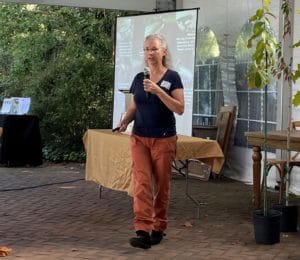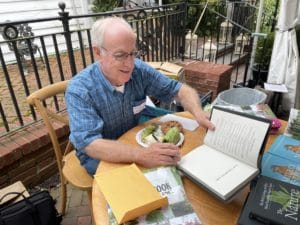Hello Fellow Readers, Native plants, especially oaks, are essential in maintaining the balance of nature. And it begins in our yards.
I recently had the privilege of attending a Plant Symposium hosted by the NJ Landscape & Nursery Association themed around organic practices and native plants to encourage biodiversity. Biodiversity, or biological diversity, pertains to all living things in a region (aka ecosystem), including fungi, bacteria, micro-organisms, insects, and other animals, including humans.
“To have butterflies, you have to have caterpillars.”
The many knowledgeable speakers include Randi Eckel of Toadshade Wildflower Farm, who spoke about the importance of native plants in the landscape. “To have butterflies, you have to have caterpillars,” Randi said, which is why leaving plant debris in the garden over winter is a critical part of a butterfly garden.
“A single nest of chickadees needs 500 caterpillars every day to feed their clutch. And hummingbirds can’t live on sugar water alone; they eat aphids and small gnats.”
I chuckled when she added, “embrace moths — they are butterflies that like to party at night.”
Strive for Seventy-Percent Native Plants versus Grass
An associate, Richard A. McCoy Horticultural Services Inc., shared how traditional landscape companies can transition to sustainable practices. His goal is to fill a property with seventy percent native plants rather than grass emphasizing soil biology and proper planting techniques. “Rather than using pesticides, build ecosystems,” he coached.
Many of us were star-struck by Douglas Tallamy, the keynote, and author of a go-to resource Bringing Nature Home. Native insects can’t or won’t eat non-native plants, so populations of desired insects are declining, depriving food for birds and other wildlife. By introducing native plants into our yards, each of us can make a difference in restoring the balance of nature.
The Nature of Oaks: The Rich Ecology of Our Most Essential Native Trees
Tallamy presented highlights from his newest book, The Nature of Oaks— “one of the most important species of the plant kingdom.” His book features fascinating details of what goes on with these majestic trees month to month, how to choose and care for them, and overcomes myths.
Overcoming Oak Myths
In the first years, oaks only have a few leaves as much of the growth is underground. The rumor of slow growth is mainly due to balled and burlapped trees (B&B’s). They grow more slowly because they are root pruned when dug for sale and need to put energy into restoring roots. Instead, Tallamy suggests planting small trees grown in pots.
Another myth, that oak roots don’t go beyond the width of the canopy. Oak (Quercus) roots intertwine and interlock with other oaks, so planting them in groups is best. “If you have a giant lawn, plant a grove of trees,” he said, though, avoid Willow Oaks (Q. phellos) as they have shallow roots. White Oak, Red Oak, and Black Oak make the best oaks in the ecosystem; choosing the right one for your landscape.
Oak leaves make the best leaf litter.
Despite the claims of the contrary, Tallamy touts oak leaves make the best leaf litter. Plants readily grow through an average level of leaves, not piled, and they provide a valuable blanket for wildlife. Oaks also provide a screen in the winter as they hold onto many leaves, nature’s way of protecting buds.
Tallamy’s talk grew not only a love of majestic oaks but also blue jays. “A single oak can make 3 million acorns in a lifetime. And a single jay in a single fall can bury 4,500 acorns — but only recovers 1 in 4. That’s how oaks move around so fast.” Of course, other critters bury acorns too. And they choose acorns from healthy oaks rather than those affected by Oak Wilt or Oak Decline.
Why don’t oaks produce the same amount of acorns each year?
Which brings the question of why don’t oaks produce the same amount of acorns each year? If they did, those that feed off them would not have checks and balances— lesser yields keep populations in check.

Larry Kruser sharing the story of Fernbrook Farms
Larry Kruser of Fernbrook Farms, host of the event, gave a tour of the 230-acre preserved farmland in his family since 1899. He points to five-foot oaks grown in pots, “just put one in for your clients, don’t tell them, and it’ll grow into a magnificent tree.”
Protecting our environment starts at home, creating gardens and landscape practices that not only encourage nature but nurture it. Garden Dilemmas? AskMaryStone@gmail.com (and on your favorite Podcast App).
For more about Blue Jays link to overcoming Blue Jays Bad Reputation
This story is featured in Episode 35 of the Garden Dilemmas Podcast:
In 2004 the Oak Becomes America’s National Tree.
Link to Douglas Tallamy’s book Nature of Oaks






